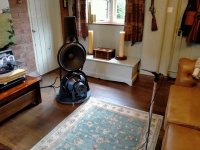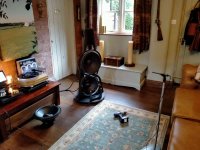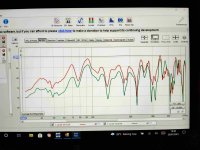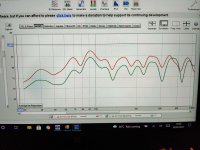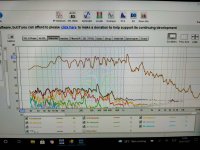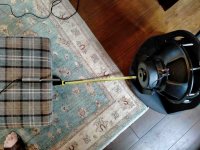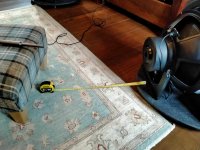And reading further info that thread, I found a post where forum member ErikdeBest has already done the measurements we are talking about:
Celestion System 6000 vs GR Research dipole bass
Here is the plot:
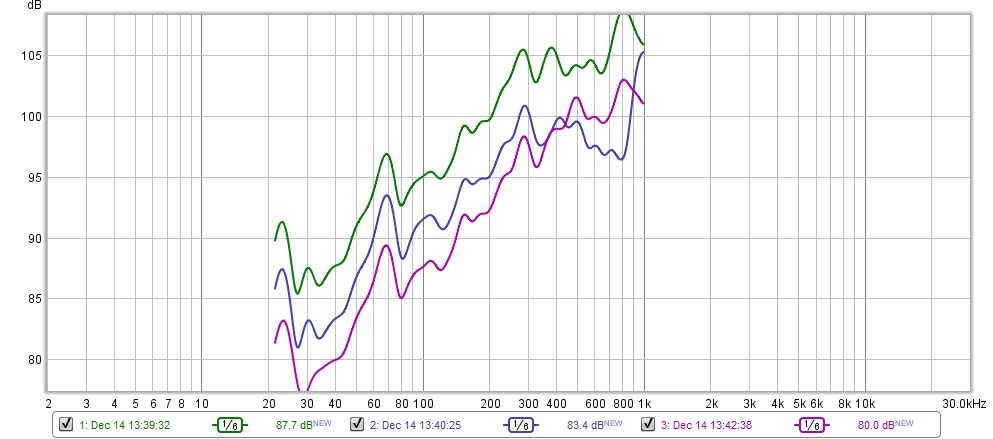
With the comment:
The drivers were connected in parallel for the two-driver systems.
Celestion System 6000 vs GR Research dipole bass
Here is the plot:
With the comment:
The most interesting is the curves shown for single unit (violet), compound (blue) and side by side (green). One sees that compound has indeed 3dB more output than single, and the side by side 6dB more as the single.
The drivers were connected in parallel for the two-driver systems.
Last edited:
Good research Charlie! I hadn't seen that! I agree - when I first came across this driver arrangement it took me a while to get my head around until I found SL's analysis which made a lot of sense to me.
I am well aware that this is likely less efficient than an H frame, but the cost of the drivers I am using is fairly low - in fact probably less than the materials to build a decent H-Frame, and as my build is essentially naked drivers - the whole speaker is remarkably compact for 2 x 15" sub-woofers in open baffle configuration!
So for me - this was a no brainer
I am well aware that this is likely less efficient than an H frame, but the cost of the drivers I am using is fairly low - in fact probably less than the materials to build a decent H-Frame, and as my build is essentially naked drivers - the whole speaker is remarkably compact for 2 x 15" sub-woofers in open baffle configuration!
So for me - this was a no brainer
And reading further info that thread, I found a post where forum member ErikdeBest has already done the measurements
.
Oh wow! that completely reflects my measurements then - shall I still take my speakers apart?!?
Compound (isobaric) might get that +6dB sensitivity by parallel electric connection? Side by side (or clamshell/slot loaded) gets more acoustic efficiency from double surface area, which is beneficial because Xmax is easily reached with huge EQ and no in-box pressurization.
Last edited:
Oh wow! that completely reflects my measurements then - shall I still take my speakers apart?!?
Eric deBest mentions (and the plots confirm) that he measured a difference of about +3dB for the compound woofer setup versus a single dipole. He said that he used a parallel wiring, so it should be the same as your case where you power both woofers using their own channel of amplification.
He says 3dB, you say 6dB. He has posted in this thread already, perhaps he can comment.
Anyway, if you can do the measurements without too much trouble it would be great to see the data.
Ok here we go.
I was dreading uncoupling a sub wasn't sure how it would sit without the clamshell geometry but as my 'hammock' sling for each driver is at the balance point it was pretty stable with just one sub attached😱
Anyway here you are😀
I was dreading uncoupling a sub wasn't sure how it would sit without the clamshell geometry but as my 'hammock' sling for each driver is at the balance point it was pretty stable with just one sub attached😱
Anyway here you are😀
Attachments
Distortion measurements and with some FDW applied.
Obviously this is with the crossovers removed and the freq is all over the place as the speaker is not in it's usual spot and neither is the mike!
Interestingly it does look like the disortion is better - similar to my first measurements- presumably due to the clamshell configuration.
Also distance 1.4M.
Obviously this is with the crossovers removed and the freq is all over the place as the speaker is not in it's usual spot and neither is the mike!
Interestingly it does look like the disortion is better - similar to my first measurements- presumably due to the clamshell configuration.
Also distance 1.4M.
Attachments
Last edited:
It's difficult for me to tell which distortion plot is for which configuration, although one is I guess a bit better than the other. Can you provide info on which is which?
Ok here we go.
I was dreading uncoupling a sub wasn't sure how it would sit without the clamshell geometry but as my 'hammock' sling for each driver is at the balance point it was pretty stable with just one sub attached😱
Anyway here you are😀
Thanks so much for measuring! It seems to be between +3dB and +6dB, depending on the frequency in question. Hmmm...
Sorry Charles first one that hits 80dB at 40Hz is both, and second one which hits 74dB at 40Hz is one sub only.
Thanks so much for measuring! It seems to be between +3dB and +6dB, depending on the frequency in question. Hmmm...
I think this is just my poor measurements or an artifact of the smoothing, as if we look at my previous measurements in post 40.
It does seem a consistent 6dB below 100hz.
I can take another set varying the mike position if you like?
Last edited:
Can you measure at 50cms from the speakers? My measurements were at 50cms, on axis, all drivers on the floor.
It might also be confounded somewhat by room interaction - the clamshell does give stronger dipole power response -which might affect things.
I think so 🙂
Just refound another thread, in post 24 there is a comment of increased sensitivity with the compound mounting. Celestion System 6000 vs GR Research dipole bass
Just refound another thread, in post 24 there is a comment of increased sensitivity with the compound mounting. Celestion System 6000 vs GR Research dipole bass
OK I have just had a thought Erik - if you are measuring that close did you account for the change in distance from the radiating surfaces?
In other words - as soon as you remove one subwoofer - depending on which one you remove the measurement distance will change.
In other words - as soon as you remove one subwoofer - depending on which one you remove the measurement distance will change.
I will take three measurements - one with the front sub off and the speaker in the same position, then one with it moved forward so the cone is 50cm from the mike as per the above photo of the full clamshell measurement, and of course one with the clamshell intact
Also, just put the mic on the floor for these measurements. Angle the mic so the tip is right against a hard surface - you could put it on a flat piece of wood (e.g. half inch thick) or tile for example. Grab a thin book from the shelf, etc. This approach is often used for ground plane measurements because it minimizes the distance to the floor boundary, and therefore moves artifacts from interference up to a rather high frequency.
Ok here we go. First measurement clamshell (Green).
Second measurement with front sub removed and speaker not moved (Brown) (which essentially moves the measurement distance from 50cm to about 70cm) and the third measurement (light green) with the speaker moved forward to keep the measurement distance at 50cm.
Second measurement with front sub removed and speaker not moved (Brown) (which essentially moves the measurement distance from 50cm to about 70cm) and the third measurement (light green) with the speaker moved forward to keep the measurement distance at 50cm.
Attachments
Last edited:
- Home
- Loudspeakers
- Multi-Way
- The 'Circles of Doom’... Open baffleless full range speakers
